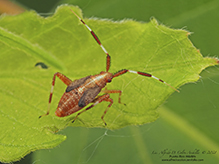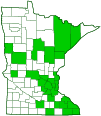plant bugs
(Neurocolpus spp.)
Overview • Description • Distribution • Taxonomy
Description |
Neurocolpus species have many morphological features common to other genera in the subfamily Mirinae. They are best identified by details of the antennae, the mouthparts (rostrum), and the hairs (pubescence); by their overall size; by their geographic range; and by their host plant preferences. Adults are 3 ⁄16″ to 5⁄16″ (4.50 to 8.50 mm) in length. The body is slender to moderately egg-shaped. The first antennal segment is thicker and stouter than the second segment. It is covered with two types of hair-like processes (setae): flattened, scale-like setae; and slender, pale to black, unbranched, hair-like setae. Segment 2 is longer than segment 1. The setae on segment 2 are hair-like, unbranched, and lying flat (recumbent). Segments 3 and 4 are much more slender than segment 2. The exoskeletal plate covering the first segment of the thorax (pronotum) has several small tufts of black, erect, stiff, bristle-like setae. It also has typical, unbranched, hair-like setae that may be erect, sub-erect, or reclining. These are intermixed with fine, silky, silvery or golden, hair-like setae. |
Distribution |
||
|
Sources Henry, T. J., & Kim, K. C. (1984). Genus Neurocolpus Reuter (Heteroptera: Miridae): Taxonomy, Economic Implications, Hosts, and Phylogenetic Review. Transactions of the American Entomological Society (1890-), 110(1), 1–75. http://www.jstor.org/stable/25078333 |
|
| 2/26/2025 | ||
Taxonomy |
|
Order |
Hemiptera (True bugs, Hoppers, Aphids, and Allies) |
Suborder |
Heteroptera (True Bugs) |
Infraorder |
Cimicomorpha |
Superfamily |
Miroidea |
Family |
|
Subfamily |
Mirinae |
Tribe |
Mirini |
Subordinate Taxa |
|
clouded plant bug (Neurocolpus nubilus) plant bug (Neurocolpus arizonae) plant bug (Neurocolpus brevicornis) plant bug (Neurocolpus clavatus) plant bug (Neurocolpus flavescens) plant bug (Neurocolpus fuscicornis) plant bug (Neurocolpus jessiae) plant bug (Neurocolpus johnstoni) plant bug (Neurocolpus knighti) plant bug (Neurocolpus longicornis) plant bug (Neurocolpus longirostris) plant bug (Neurocolpus mexicanus) plant bug (Neurocolpus montanus) plant bug (Neurocolpus nicholi) plant bug (Neurocolpus ornatus) plant bug (Neurocolpus pumilus) plant bug (Neurocolpus scutellatus) plant bug (Neurocolpus simplex) plant bug (Neurocolpus tiliae) |
|
Synonyms |
|
|
|
Common Names |
|
This genus has no common name. The common name of the family Miridae is plant bugs, and it is applied here for convenience. |
|
Glossary
Pronotum
The exoskeletal plate on the upper side of the first segment of the thorax of an insect.
Pubescence
On plants: the fuzzy hairs on a leaf, bud, stem, fruit, flower, or other structure. On insects and arachnids: the hair-like processes (setae) on the body.
Rostrum
The stiff, beak-like projection of the carapace or prolongation of the head of an insect, crustacean, or cetacean.
Seta
A stiff, hair-like process on the outer surface of an organism. In Lepidoptera: A usually rigid bristle- or hair-like outgrowth used to sense touch. In mosses: The stalk supporting a spore-bearing capsule and supplying it with nutrients. Plural: setae. Adjective: setose.
Visitor Photos |
||
Share your photo of this insect. |
||
This button not working for you? |
||
Alfredo Colon |
 |
MinnesotaSeasons.com Photos |
||
|
||
|
||

Slideshows |
|

Visitor Videos |
||
Share your video of this insect. |
||
This button not working for you? |
||
|
Other Videos |
||
|

|
Created: 2/26/2025 Last Updated: © MinnesotaSeasons.com. All rights reserved. |


